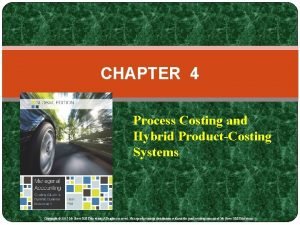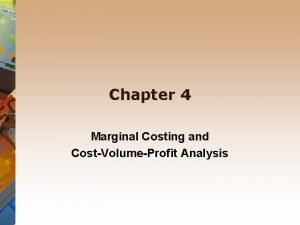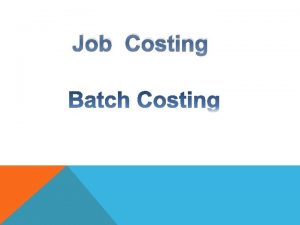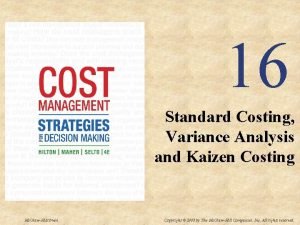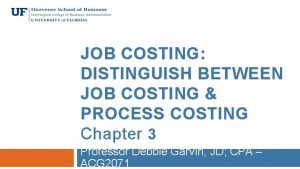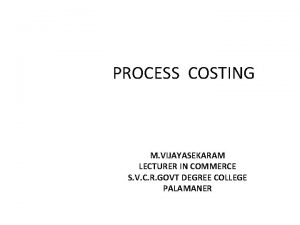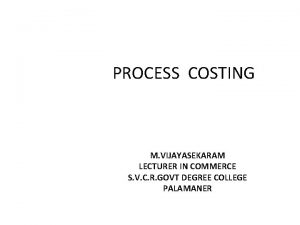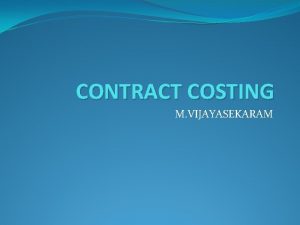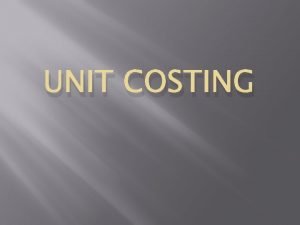OPERATING COSTING M VIJAYASEKARAM LECTURER IN COMMERCE S






- Slides: 6

OPERATING COSTING M. VIJAYASEKARAM LECTURER IN COMMERCE S. V. C. R. GOVT DEGREE COLLEGE PALAMANER

FIXED COSTS A fixed cost is one that does not change with an increase or decrease in sales or productivity and must be paid regardless of the company’s activity or performance. For example, a manufacturing company must pay rent for factory space, regardless of how much it is producing or earning. While it can downsize and reduce the cost of its rent payments, it cannot eliminate these costs, and so they are considered to be fixed. Fixed costs generally include overhead costs, insurance, security, and equipment.

FIXED COSTS CAN HELP IN ACHIEVING ECONOMIES OF SCALE, AS WHEN MANY OF A COMPANY’S COSTS ARE FIXED THE COMPANY CAN MAKE MORE PROFIT PER UNIT AS IT PRODUCES MORE UNITS. IN THIS SYSTEM, FIXED COSTS ARE SPREAD OUT OVER THE NUMBER OF UNITS PRODUCED, MAKING PRODUCTION MORE EFFICIENT AS PRODUCTION INCREASES BY REDUCING THE AVERAGE PER-UNIT COST OF PRODUCTION. ECONOMIES OF SCALE CAN ALLOW LARGE COMPANIES TO SELL THE SAME GOODS AS SMALLER COMPANIES FOR LOWER PRICES.

FIXED COSTS CAN HELP IN ACHIEVING ECONOMIES OF SCALE, AS WHEN MANY OF A COMPANY’S COSTS ARE FIXED THE COMPANY CAN MAKE MORE PROFIT PER UNIT AS IT PRODUCES MORE UNITS. IN THIS SYSTEM, FIXED COSTS ARE SPREAD OUT OVER THE NUMBER OF UNITS PRODUCED, MAKING PRODUCTION MORE EFFICIENT AS PRODUCTION INCREASES BY REDUCING THE AVERAGE PER-UNIT COST OF PRODUCTION. ECONOMIES OF SCALE CAN ALLOW LARGE COMPANIES TO SELL THE SAME GOODS AS SMALLER COMPANIES FOR LOWER PRICES.

VARIABLE COSTS Variable costs, like the name implies, are comprised of costs that vary with production. Unlike fixed costs, variable costs increase as production increases and decrease as production decreases. Examples of variable costs include raw material costs, payroll, and the cost of electricity. For example, in order for a fast-food restaurant chain that sells French fries to increase its fry sales, it will need to increase its purchase orders of potatoes from its supplier. It's sometimes possible for a company to achieve a volume discount or "price break" when purchasing supplies in bulk, wherein the seller agrees to slightly reduce the perunit cost in exchange for the buyer’s agreement to regularly buy the supplies in large amounts. As a result, the agreement might diminish the correlation somewhat between an increase or decrease in production and an increase or decrease in the company’s operating costs. For example, the fast-food company may buy its potatoes at $0. 50 per pound when it buys potatoes in amounts of less than 200 pounds. However, the potato supplier may offer the restaurant chain a price of $0. 45 per pound when it buys potatoes in bulk amounts of 200 to 500 pounds. Volume discounts generally have a small impact on the correlation between production and variable costs and the trend otherwise remains the same. Typically, companies with a high proportion of variable costs relative to fixed costs are considered to be less volatile, as their profits are more dependent on the success of their sales. In the same way, the profitability and risk for the same companies are also easier to gauge.

SEMI-VARIABLE COSTS In addition to fixed and variable costs, it is also possible for a company’s operating costs to be considered semi-variable (or “semi-fixed. ") These costs represent a mixture of fixed and variable components and, thus, can be thought of as existing between fixed costs and variable costs. Semi-variable costs vary in part with increases or decreases in production, like variable costs, but still exist when production is zero, like fixed costs. This is what primarily differentiates semi-variable costs from fixed costs and variable costs. An example of semi-variable costs is overtime labor. Regular wages for workers are generally considered to be fixed costs, as while a company’s management can reduce the number of workers and paid work-hours, it will always need a workforce of some size to function. Overtime payments are often considered to be variable costs, as the number of overtime hours that a company pays its workers will generally rise with increased production and drop with reduced production. When wages are paid based on conditions of productivity allowing for overtime, the cost has both fixed and variable components and are therefore considered to be semi-variable costs.

